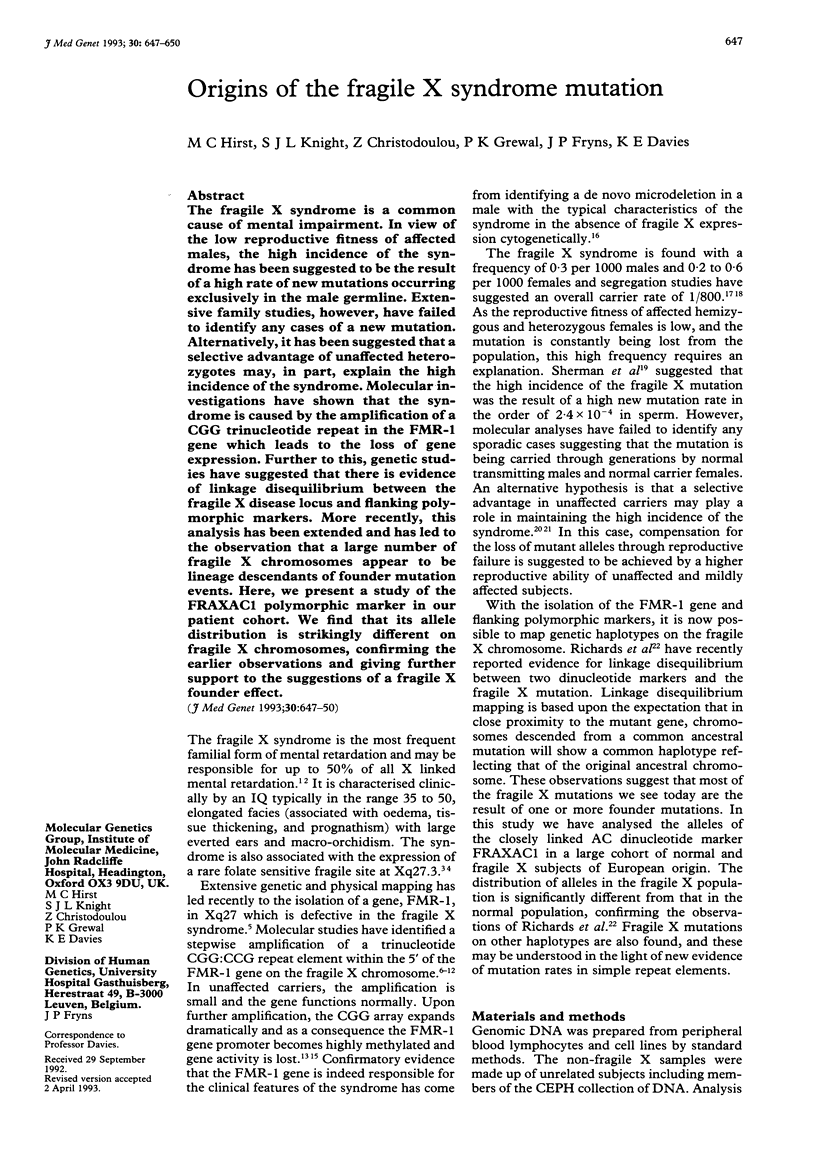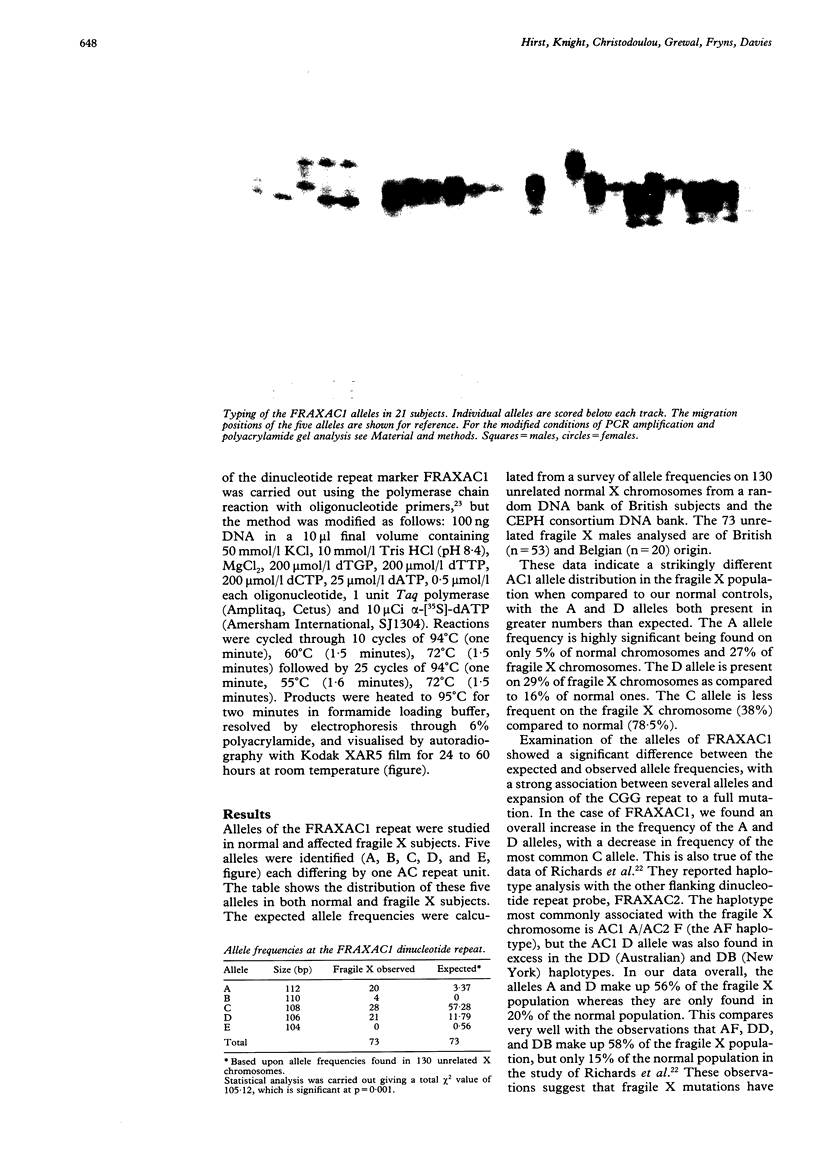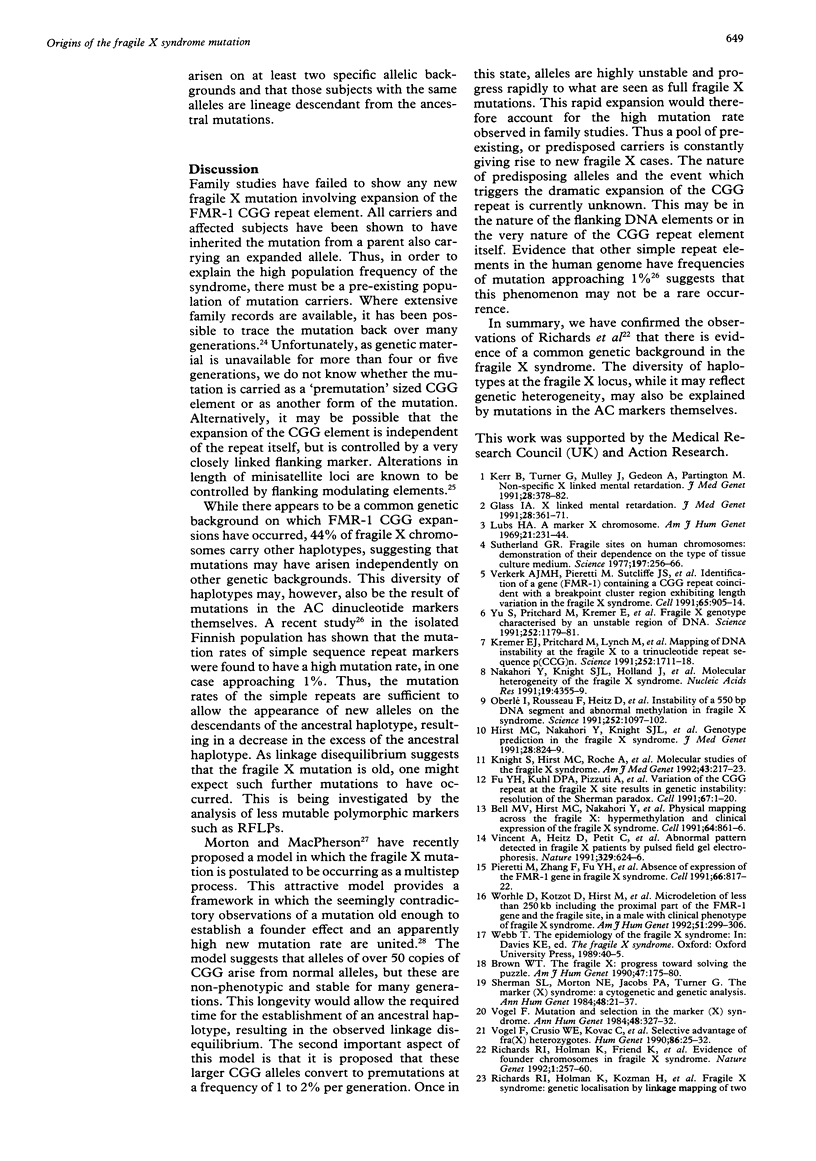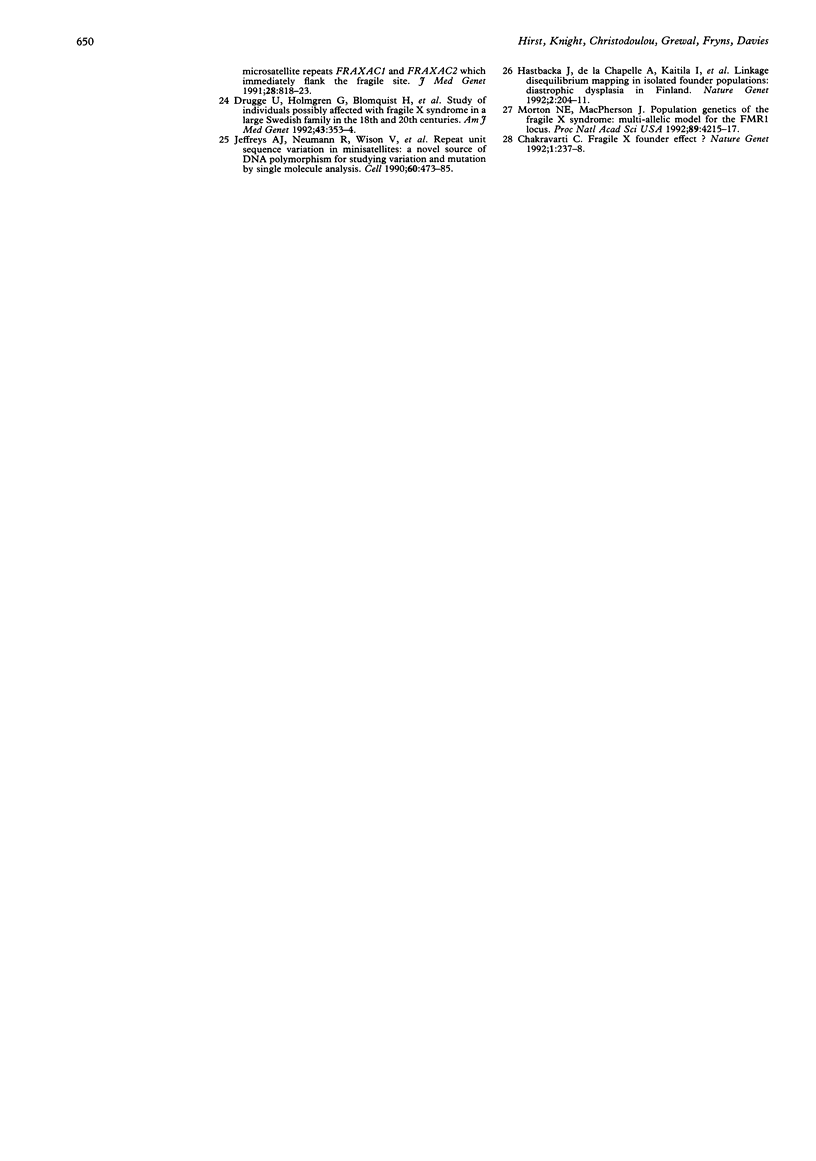Abstract
The fragile X syndrome is a common cause of mental impairment. In view of the low reproductive fitness of affected males, the high incidence of the syndrome has been suggested to be the result of a high rate of new mutations occurring exclusively in the male germline. Extensive family studies, however, have failed to identify any cases of a new mutation. Alternatively, it has been suggested that a selective advantage of unaffected heterozygotes may, in part, explain the high incidence of the syndrome. Molecular investigations have shown that the syndrome is caused by the amplification of a CGG trinucleotide repeat in the FMR-1 gene which leads to the loss of gene expression. Further to this, genetic studies have suggested that there is evidence of linkage disequilibrium between the fragile X disease locus and flanking polymorphic markers. More recently, this analysis has been extended and has led to the observation that a large number of fragile X chromosomes appear to be lineage descendants of founder mutation events. Here, we present a study of the FRAXAC1 polymorphic marker in our patient cohort. We find that its allele distribution is strikingly different on fragile X chromosomes, confirming the earlier observations and giving further support to the suggestions of a fragile X founder effect.
Full text
PDF



Images in this article
Selected References
These references are in PubMed. This may not be the complete list of references from this article.
- Bell M. V., Hirst M. C., Nakahori Y., MacKinnon R. N., Roche A., Flint T. J., Jacobs P. A., Tommerup N., Tranebjaerg L., Froster-Iskenius U. Physical mapping across the fragile X: hypermethylation and clinical expression of the fragile X syndrome. Cell. 1991 Feb 22;64(4):861–866. doi: 10.1016/0092-8674(91)90514-y. [DOI] [PubMed] [Google Scholar]
- Brown W. T. The fragile X: progress toward solving the puzzle. Am J Hum Genet. 1990 Aug;47(2):175–180. [PMC free article] [PubMed] [Google Scholar]
- Drugge U., Holmgren G., Blomquist H. K., Dahl N., Gustavson K. H., Malmgren H. Study of individuals possibly affected with the fragile X syndrome in a large Swedish family in the 18th to 20th centuries. 1992 Apr 15-May 1Am J Med Genet. 43(1-2):353–354. doi: 10.1002/ajmg.1320430154. [DOI] [PubMed] [Google Scholar]
- Glass I. A. X linked mental retardation. J Med Genet. 1991 Jun;28(6):361–371. doi: 10.1136/jmg.28.6.361. [DOI] [PMC free article] [PubMed] [Google Scholar]
- Hirst M. C., Nakahori Y., Knight S. J., Schwartz C., Thibodeau S. N., Roche A., Flint T. J., Connor J. M., Fryns J. P., Davies K. E. Genotype prediction in the fragile X syndrome. J Med Genet. 1991 Dec;28(12):824–829. doi: 10.1136/jmg.28.12.824. [DOI] [PMC free article] [PubMed] [Google Scholar]
- Hästbacka J., de la Chapelle A., Kaitila I., Sistonen P., Weaver A., Lander E. Linkage disequilibrium mapping in isolated founder populations: diastrophic dysplasia in Finland. Nat Genet. 1992 Nov;2(3):204–211. doi: 10.1038/ng1192-204. [DOI] [PubMed] [Google Scholar]
- Jeffreys A. J., Neumann R., Wilson V. Repeat unit sequence variation in minisatellites: a novel source of DNA polymorphism for studying variation and mutation by single molecule analysis. Cell. 1990 Feb 9;60(3):473–485. doi: 10.1016/0092-8674(90)90598-9. [DOI] [PubMed] [Google Scholar]
- Kerr B., Turner G., Mulley J., Gedeon A., Partington M. Non-specific X linked mental retardation. J Med Genet. 1991 Jun;28(6):378–382. doi: 10.1136/jmg.28.6.378. [DOI] [PMC free article] [PubMed] [Google Scholar]
- Knight S. J., Hirst M. C., Roche A., Christodoulou Z., Huson S. M., Winter R., Fitchett M., McKinley M. J., Lindenbaum R. H., Nakahori Y. Molecular studies of the fragile X syndrome. 1992 Apr 15-May 1Am J Med Genet. 43(1-2):217–223. doi: 10.1002/ajmg.1320430135. [DOI] [PubMed] [Google Scholar]
- Kremer E. J., Pritchard M., Lynch M., Yu S., Holman K., Baker E., Warren S. T., Schlessinger D., Sutherland G. R., Richards R. I. Mapping of DNA instability at the fragile X to a trinucleotide repeat sequence p(CCG)n. Science. 1991 Jun 21;252(5013):1711–1714. doi: 10.1126/science.1675488. [DOI] [PubMed] [Google Scholar]
- Lubs H. A. A marker X chromosome. Am J Hum Genet. 1969 May;21(3):231–244. [PMC free article] [PubMed] [Google Scholar]
- Morton N. E., Macpherson J. N. Population genetics of the fragile-X syndrome: multiallelic model for the FMR1 locus. Proc Natl Acad Sci U S A. 1992 May 1;89(9):4215–4217. doi: 10.1073/pnas.89.9.4215. [DOI] [PMC free article] [PubMed] [Google Scholar]
- Nakahori Y., Knight S. J., Holland J., Schwartz C., Roche A., Tarleton J., Wong S., Flint T. J., Froster-Iskenius U., Bentley D. Molecular heterogeneity of the fragile X syndrome. Nucleic Acids Res. 1991 Aug 25;19(16):4355–4359. doi: 10.1093/nar/19.16.4355. [DOI] [PMC free article] [PubMed] [Google Scholar]
- Nicola N. A., Metcalf D. Subunit promiscuity among hemopoietic growth factor receptors. Cell. 1991 Oct 4;67(1):1–4. doi: 10.1016/0092-8674(91)90564-f. [DOI] [PubMed] [Google Scholar]
- Pieretti M., Zhang F. P., Fu Y. H., Warren S. T., Oostra B. A., Caskey C. T., Nelson D. L. Absence of expression of the FMR-1 gene in fragile X syndrome. Cell. 1991 Aug 23;66(4):817–822. doi: 10.1016/0092-8674(91)90125-i. [DOI] [PubMed] [Google Scholar]
- Richards R. I., Holman K., Friend K., Kremer E., Hillen D., Staples A., Brown W. T., Goonewardena P., Tarleton J., Schwartz C. Evidence of founder chromosomes in fragile X syndrome. Nat Genet. 1992 Jul;1(4):257–260. doi: 10.1038/ng0792-257. [DOI] [PubMed] [Google Scholar]
- Richards R. I., Holman K., Kozman H., Kremer E., Lynch M., Pritchard M., Yu S., Mulley J., Sutherland G. R. Fragile X syndrome: genetic localisation by linkage mapping of two microsatellite repeats FRAXAC1 and FRAXAC2 which immediately flank the fragile site. J Med Genet. 1991 Dec;28(12):818–823. doi: 10.1136/jmg.28.12.818. [DOI] [PMC free article] [PubMed] [Google Scholar]
- Sherman S. L., Morton N. E., Jacobs P. A., Turner G. The marker (X) syndrome: a cytogenetic and genetic analysis. Ann Hum Genet. 1984 Jan;48(Pt 1):21–37. doi: 10.1111/j.1469-1809.1984.tb00830.x. [DOI] [PubMed] [Google Scholar]
- Verkerk A. J., Pieretti M., Sutcliffe J. S., Fu Y. H., Kuhl D. P., Pizzuti A., Reiner O., Richards S., Victoria M. F., Zhang F. P. Identification of a gene (FMR-1) containing a CGG repeat coincident with a breakpoint cluster region exhibiting length variation in fragile X syndrome. Cell. 1991 May 31;65(5):905–914. doi: 10.1016/0092-8674(91)90397-h. [DOI] [PubMed] [Google Scholar]
- Vincent A., Heitz D., Petit C., Kretz C., Oberlé I., Mandel J. L. Abnormal pattern detected in fragile-X patients by pulsed-field gel electrophoresis. Nature. 1991 Feb 14;349(6310):624–626. doi: 10.1038/349624a0. [DOI] [PubMed] [Google Scholar]
- Vogel F., Crusio W. E., Kovac C., Fryns J. P., Freund M. Selective advantage of fra (X) heterozygotes. Hum Genet. 1990 Nov;86(1):25–32. doi: 10.1007/BF00205167. [DOI] [PubMed] [Google Scholar]
- Vogel F. Mutation and selection in the marker (X) syndrome. A hypothesis. Ann Hum Genet. 1984 Oct;48(Pt 4):327–332. doi: 10.1111/j.1469-1809.1984.tb00846.x. [DOI] [PubMed] [Google Scholar]
- Wöhrle D., Kotzot D., Hirst M. C., Manca A., Korn B., Schmidt A., Barbi G., Rott H. D., Poustka A., Davies K. E. A microdeletion of less than 250 kb, including the proximal part of the FMR-I gene and the fragile-X site, in a male with the clinical phenotype of fragile-X syndrome. Am J Hum Genet. 1992 Aug;51(2):299–306. [PMC free article] [PubMed] [Google Scholar]
- Yu S., Pritchard M., Kremer E., Lynch M., Nancarrow J., Baker E., Holman K., Mulley J. C., Warren S. T., Schlessinger D. Fragile X genotype characterized by an unstable region of DNA. Science. 1991 May 24;252(5009):1179–1181. doi: 10.1126/science.252.5009.1179. [DOI] [PubMed] [Google Scholar]



